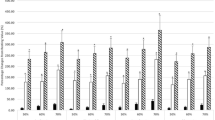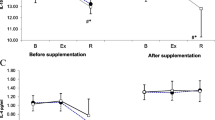Summary
Leucocyte cell counts and the phagocytic and chemotactic activities of neutrophil granulocytes were investigated in highly endurance-trained long-distance runners (n = 10) and triathletes (n = 10) during a moderate training period and compared with untrained subjects (n= 0) before and up to 24 h after a graded exercise to exhaustion on a treadmill. After exercise a leucocytosis was noted with a significant increase in lymphocyte (P≤0.01) and neutrophil (P≤0.01) counts in all groups. In neutrophils the number of ingested inert latex beads was significantly increased (P ≤ 0.01) from 0.21 (SD 0.09) to 0.45 (SD 0.22) in controls, from 0.20 (SD 0.12) to 0.56 (SD 0.16) in long-distance runners and from 0.25 (SD 0.08) to 1.03 (SD 0.42) particles per cell in triathletes 24 h after exercise, compared with resting values. The capability of neutrophils to produce microbicidal reactive oxygen species fell (P:_ 0.05) immediately after exercise in all subjects and then increased by 36 (SD 8) %, 31 (SD 6) % and 19 (SD 9) % in controls, runners and triathletes respectively up to 24 h after exercise (P≤ 0.05) compared with pre-start values. With respect to the absolute number of neutrophils, ingestion capacity, production of superoxide anions and chemotactic activity, no significant differences were found between athletes and control subjects at rest and after exercise. These data indicate, on the one hand, no impairment of the granulocyte system during a moderate training period in long-distance runners and triathletes but, on the other, that the prolonged activation of the phagocytosis reaction after exercise might impair the granulocyte system in periods of intensive training with high training frequency.
Similar content being viewed by others
References
Bass DB, Olbrantz P, Szejda P, Seeds MC, McCall CE (1986) Subpopulations of neutrophils with increased oxidative product formation in blood of patients with infection. J Immunol 136:860–866
Boyum A (1968) Isolation of mononuclear cells and granulocytes from human blood. Scand J Lab Invest 21:77–89
Curnutte JT (1988) Classification of chronic granulomatous disease. Hematol Oncol Clin North Am 2:241–252
Dill DB, Costill DL (1974) Calculation of percentage changes in volumes of blood, plasma, and red cells in dehydration. J Appl Physiol 37:247–248
Fitzgerald L (1988) Exercise and the immune system. Immunol Today 9:337–339
Fitzgerald L (1991) Overtraining increases the susceptibility to infection. Int J Sports Med 12:S5-S8
Ford WL, Hunt SV (1979) The preparation and labelling of lymphocytes. In: Weir M (ed) Handbook of experimental immunology. Blackwell, Oxford, pp 23.10–23.17
Frey RW, Morton AR, Crawford GPM, Keast D (1992) Cell numbers and in vitro responses of leucocytes and lymphocyte subpopulations following maximal exercise and interval training sessions of different intensities. Eur J Appl Physiol 64:218–227
Gallin JI (1984) Human neutrophil heterogeneity exists, but is it meaningful? Blood 63:977–983
Gaudry M, Combadiere C, Marquetty C, Sheibani A, El Benna J, Hakim J (1990) Dissimilarities in superoxide anion production by human neutrophils stimulated by phorbol myristate acetate or phorbol dibutyrate. Immunopharmacology 19:23–32
Hansen JB, Wilsgård L, Osterud B (1991) Biphasic changes in leukocytes induced by strenuous exercise. Eur J Appl Physiol 62:157–161
Heath GW, Ford ES, Craven TE, Macera CA, Jackson KL, Pate RR (1991) Exercise and the incidence of upper respiratory tract infections. Med Sci Sport Exerc 23:152–157
Keast D, Cameron K, Morton AR (1988) Exercise and the immune response. Sports Med 5:248–267
Lew D (1990) Receptors and intracellular signalling in human neutrophils. Am Rev Respir Dis 141:8127–8131
Lewicki R, Tchórzewski H,Denys A, Kowalska M, Golinska A (1987) Effect of physical exercise on some parameters of immunity in conditioned sportsmen. Int J Sports Med 8:309–314
Liesen H, Riedel H, Order U, Mücke S, Widenmayer W (1989) Zelluläre Immunität bei Hochleistungssportlern. Dtsch Z Sportmed 40:S4-S14
Macha M, Shlafer M, Kluger MJ (1990) Human neutrophil hydrogen peroxide generation following physical exercise. J Sports Med Phys Fitness 30:412–419
Mackinnon LT, Tomasi TB (1986) Immunology of exercise. Ann Sports Med 3:1–3
Massey V (1959) The microestimation of succinate and the extinction coefficient of cytochrom c. Biochim Biophys Acta 34:255–256
McCarthy DA, Dale MM (1988) The leukocytosis of exercise. A review and model. Sports Med 6:333–363
Miyagawa H, Okada C, Sugiyama H, Hopp RJ, Agrawal DK, Nabe M, Gordy C, Bewtra AK, Townley RG (1990) Density distribution and density conversion of neutrophils in allergic subjects. Int Arch Allergy Appl Immunol 93:8–13
Nehlsen-Cannarella SL, Nieman DC, Blak-Lamberton AJ, Markoff PA, Chritton DBW, Gusewitch G, Lee JW (1991) The effects of moderate exercise training on immune response. Med Sci Sports Exerc 23:64–70
Nelson RD, Herron MJ (1988) Agarose method for human neutrophil chemotaxis. Methods Enzymol 162:51–59
Nieman DC, Nehlsen-Cannarella SL, Markoff PA, Balk-Lamberton AJ, Yang H, Chritton DBW, Lee JW, Arabatzis K (1990) The effect of moderate exercise training on natural killer cells and acute upper respiratory tract infections. Int J Sports Med 11:467–473
Pedersen BK (1991) Influence of physical activity on the cellular immune system: mechanisms of action. Int J Sports Med 12:523-S29
Rodriguez AB, Barriga C, De la Fuente M (1991) Phagocytic function of blood neutrophils in sedentary young people after physical exercise. Int J Sports Med 12:276–280
Sawyer DW, Donowitz GR, Mandell GL (1989) Polymorphonuclear neutrophils: an effective antimicrobial force. Rev Infect Dis 11:S1532-S1544
Schroeder F, Kinden DA (1983) Measurement of phagocytosis using fluorescent latex beads. J Biochem Biophys Methods 8:1527
Simon HB (1984) The immunology of exercise. JAMA 252:2735–2738
Smith JA, Telford RD, Mason IB, Weidemann MJ (1990) Exercise, training and neutrophil microbicidal activity. Int J Sports Med 11:179–187
Thompson RA (1988) Immunodeficiency due to defects of polymorphonuclear leukocyte function. Immunol Invest 17:85–92
Yamazaki M, Matsuoka T, Yasui K, Komiyama A, Akabane T (1989) Dopamine inhibition of superoxide anion production by polymorphonuclear leukocytes. J Allergy Clin Immunol 83:967–972
Weingarten R, Bokoch GM (1990) GTP binding proteins and signal transduction in the human neutrophil. Immunol Lett 26:1–6
Author information
Authors and Affiliations
Rights and permissions
About this article
Cite this article
Hack, V., Strobel, G., Rau, J.P. et al. The effect of maximal exercise on the activity of neutrophil granulocytes in highly trained athletes in a moderate training period. Europ. J. Appl. Physiol. 65, 520–524 (1992). https://doi.org/10.1007/BF00602358
Accepted:
Issue Date:
DOI: https://doi.org/10.1007/BF00602358




